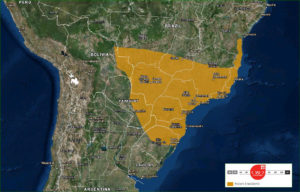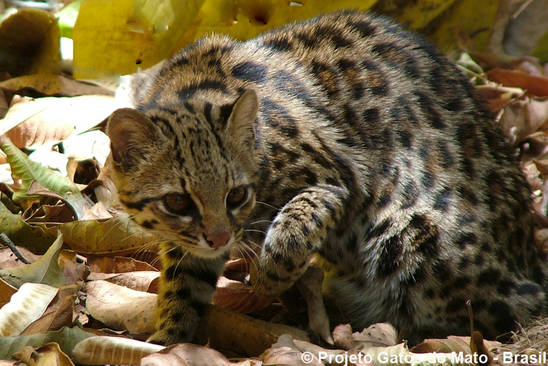Click here to see our fact sheet Tiger Cat Species Complex for new classification of Tiger Cats (2024)

- HB length: 38-59 cm (15-23″)
- Tail length: 20-42 cm (7.8-16″)
- Height: approx 20 cm (8″)
- Weight: 1.8-3.5 kg (4-8 lbs)
- Population Trend: Decreasing
Southern Tiger cats Leopardus guttulus were previously referred to as Oncillas, Tigrinas, Small-spotted cats or Tiger cats. In 2013 after genetic testing, the Oncilla was split into two species and they are now referred to as either Southern Tiger Cats Leopardus guttulus or Northern Tiger Cats Leopardus tigrinus.
Tiger cats are one of the smallest cat species in the Americas, averaging just 2.5 kg. However, while some individuals are small, weighing only 1.8 kg, others are large with a weight of 3.5 kg. They are daintily built cats, with a narrow head and a white line above the eyes. The large ears have a black backside with a central white spot. The irises are golden or light brown. Males are slightly, but significantly, larger than females.
Generally paler overall than the Northern Tiger Cat, the fur of the Southern Tiger cat has a yellowish-brown ground colour, with large, rounded open rosettes. Melanism is common. The paler belly fur is covered with dark spots.
The fur is firm, lies close to the skin and does not turn forward in the nape region as it does on the Ocelot Leopardus pardalis and Margay Leoparus wiedii. Limbs are spotted on the outside and the long tail has spots at the root, developing into seven to thirteen irregular rings with a black tip. The tail measures about 60% of the head and body length.
Distribution

The Southern Tiger cat ranges from Central to southern Brazil, eastern Paraguay and north-eastern Argentina. The species is absent from the Paraguayan Chaco. The northern limits of its geographic range are still unclear. It reaches Central Brazil in the states of Minas Gerais, Goiás and the Atlantic forest of central-south Bahia in the northeast region. Whether it overlaps with Northern Tiger Cats Leopardus tigrinus and to what extent is still not known.
Southern Tiger cat population densities vary, but tend to be low throughout most of its range, these cats occur at densities typically of 1-5/100 km². Especially in protected areas it is very rare, most probably due to the negative impact of the Ocelot. Only in a few areas, where Ocelots are absent or rare, it reaches densities of 15–25/100 km².
Habitat
The Southern Tiger cat occurs in a variety of habitats, from dense tropical and subtropical rainforests, deciduous/semi-deciduous, and mixed pine forests, to the open savannah, and beach vegetation. In the Pantanal (wet/swampy savannah), it is very rare and has been recorded only in the dry savannas, not in the marshy areas. The Southern Tiger cat also inhabits disturbed areas such as agricultural fields where there is an abundance of rodents but its occurrence is limited by the presence of natural cover. Both telemetry information and scat analysis indicate the cats do not venture into disturbed areas, but only use their borders. Rodent abundance is increased in these areas. Known altitudinal range of the Southern Tiger cat is below 2,000 m.
As a generalist carnivore and the largest and most adaptable of the small cat species in tropical America, the Ocelot dominates the other small cat species. In areas where the Ocelot occurs, species like the Southern Tiger cat avoid those areas because of the threat of predation. This negative effect on other small cat species is called the “ocelot effect”. When Ocelots inhabit protected areas, the smaller cats can be forced into adjacent unprotected areas, where the threat of habitat loss and human interaction is greater.
Ecology
The Southern Tiger cat is a solitary felid. It is active predominantly at night, but can also show varying degrees of diurnal activity. This activity during any time of the day is suggested as a strategy to avoid the Ocelot. On the other hand, Tiger cat numbers are not affected by the presence of the Margay and Jaguarundi, which are more likely potential competitors for similar sized prey.
Tiger cats are excellent climbers, but spend most of their time on the ground as most of their prey is terrestrial. When threatened, they show an aggressive behavior with arched back and raised hair, besides showing the teeth and producing a “whistling-spitting” vocalization.
The Southern Tiger cat’s diet is still very poorly studied, but is known to consist mostly of small mammals, birds and reptiles (especially lizards) and can include larger prey over 1 kg. This suggests that this small felid is a generalist predator, taking advantage of the most readily available resources in the area.
Reproduction
Very little information about the Tiger cat’s reproduction in the wild is available. Reproduction occurs year round, but could show different peaks in different areas. The gestation period lasts for 75-78 days, after which 1-3 kittens are born, but the normal litter is one. The eyes are open at 8–17 days. Weaning occurs at two to three months and young are about adult body size at 11 months of age.
However, sexual maturity is achieved only at about 2-2.5 years, which is very late for a felid this size. The lifetime number of young potentially produced by a seven year old female tiger cat in the wild is generally up to five. This shows a very low reproductive potential, considering its small size and, especially, compared to other felids from other continents. Longevity is reported as 15 – 21 years.
Threats
- habitat loss and fragmentation
- persecution by humans
- killing due to poultry depredation
- vehicle collisions on roads
- exposure to domestic carnivore diseases
- lack of knowledge of the species, making it impossible to determine its ecology and status
Conservation
The Southern Tiger cat is classified as Vulnerable in the IUCN Red List. Population decline by almost 50% in eight years was observed in the Santa Catarina state of Brazil, the main range country for the species.The Southern Tiger cat also declined in other areas by more than 50%.
Tiger cats are protected over part of their range. Hunting is prohibited in Argentina, Brazil, Colombia, Paraguay, Costa Rica, French Guiana, Suriname and Venezuela, but they are not legally protected in Ecuador, Guyana, Nicaragua, Panama and Peru.
Although the international trade in furs has been heavily reduced, illegal hunting and capturing still takes place, mostly for the local market. Historical trade on tiger cats (which would include both species) from 1976 to 1985 consisted of astonishing 352,508 skins.
The Brazilian Cerrado is being converted for grains and loss of natural cover in the Brazilian Cerrado and Caatinga reaches 55% and 30–50%, respectively. As the Tiger cat shows low densities in protected areas and populations are fragmented, it is even more vulnerable to habitat conversion. Since this felid is most frequent outside protected areas where its habitat is undergoing high rates of destruction, conservation efforts should be focused on those outside protected areas.
Another problem is the lack of knowledge of this cat species. Very little information is available about the Southern Tiger cat’s ecology and status making it difficult to assess threats and their impact. Further research on the ecology, natural history and threats is urgently needed. To monitor and understand the extent of hybridization with Geoffroy’s cat is another research priority.
Range map IUCN Red List 2018
Updated 2024
